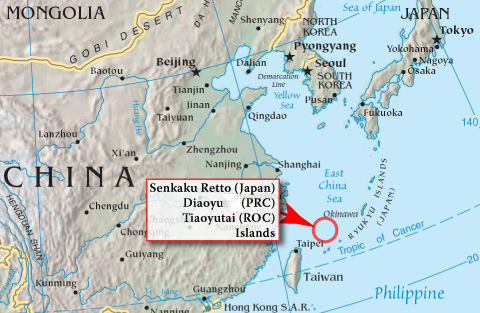Japan plans defense against Chinese invasion

Sunday, January 16, 2005
East China Sea — Japan plans to deploy 55,000 troops, along with planes, warships, and submarines, in the event of a Chinese invasion of a remote southern island chain.
This new policy contrasts sharply with public comments by Japan's Chief Cabinet Secretary Hiroyuki Hosoda, who as recently as December claimed that Japan did not view China as a threat.
Japan Defense Agency Director General Yoshinori Ono pointed to an incursion into the area by a Chinese nuclear submarine last November, which has raised the profile of the political dispute over administrative rights for the islands. China has also increased its marine surveillance of the area in recent months.
The release of such detailed plans by the Japan Defense Agency sends a strong message to China—that Japan plans to protect its claimed administrative rights over the area at all costs. Many Japanese believe "that their government should take an even tougher stance toward China", according to Ho Szu-shen, an associate professor in the Department of Japanese at Fu-jen Catholic University.
The Chinese government has not yet commented publicly about the release of the Japanese defense plans for the islands. However, in December, the state-run People's Daily newspaper editorialized that Japan's multi-year Defense Forces Reorganization Plan attempts to "play up Chinese military threats." China is also unhappy with Japan's plans to build a missile defense system in cooperation with the United States.
Sovereignty of the island is disputed between Japan and China. Both the People's Republic of China and the Republic of China claims soveregnty on the island.
Despite Japan's claims of sovereignty over the islands, China has begun to claim some of the region's valuable oil and natural gas deposits to help alleviate the shortages for China's growing economy. China recently allowed leased oil drilling to commence within the area that Japan has declared as an "Economic Exclusion Zone". Japan has lodged diplomatic protests to ask China to discontinue these projects, but China does not recognize Japan's claims, arguing that Chinese territorial rights end at the edge of the Asian continental shelf underneath the East China Sea.
On March 24, 2004, seven Chinese activists were arrested by Japanese authorities when they landed on the islands with the intent to stay for three days. At the time, the Japanese Ministry of Foreign Affairs lodged a protest with the PRC. The activists were deported by Japan after the PRC demanded their return.
The name of the island chain is disputed. The Japanese refer to the islands as "Sento Shosho" or "Senkaku Retto," the People's Republic of China (PRC) and the Republic of China (Taiwan) call the island the same name. In PRC's pinyin system, the names spells "Diaoyu Dao" and in ROC's system "Tiao Yu Tai."
Sources
- "Defense plan prepared for remote islands" — The Japan Times, January 16, 2005
- Janice Tang. "A vicious cycle with China" — Japan Today, December 11, 2004
- "More troops to guard southern isles" — The Japan Times, September 21, 2004
- Ho Szu-shen 何思慎. "China interested in Japan's waters" — Taipei Times, September 9, 2004
- "The Basic View on the Sovereignty over the Senkaku Islands" — The Ministry of Foreign Affairs of Japan, Undated
- Japan Defense Agency Japanese-language home page
